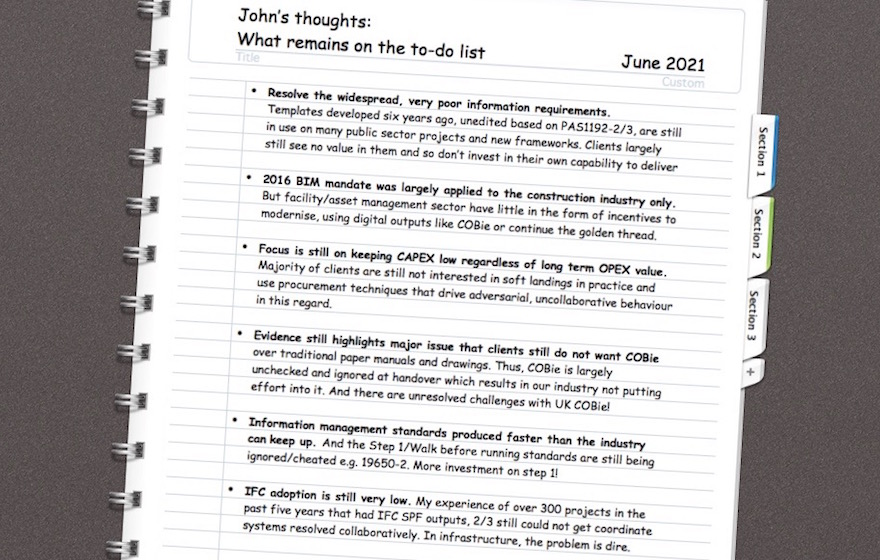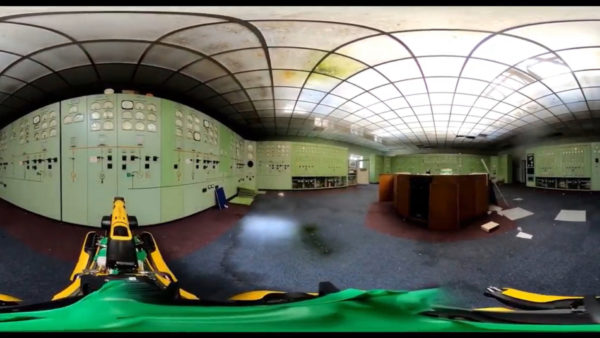To mark the 10th anniversary of the 2011 Government Construction Strategy and the BIM mandate, Gallford Try BIM and digital lead John Ford reviews BIM’s journey, noting its successes and where it has fallen short.
Ten years ago, the BIM Industry working group drafted a report to government recommending BIM as a mandatory enabler for the sector with the aim to achieve cost savings through the construction phase of a project of between 5%-10% and potentially deliver further gains through the life-cycle of the finished structure.
Although most people did not realise at the time, this report acted as one of the most detailed definitions of ‘BIM Level 2’ as many of its recommendations were eventually incorporated into the PAS1192-2:2013 standard, which fundamentally defined the process underpinning the (now withdrawn) BIM Level 2 concept.
A few months later, the findings of this report made their way into the 2011 Government Construction Strategy which heeded its recommendations and made BIM mandatory from 2016 onwards.
What was the aim?
With the hope of achieving potentially billions in savings, it was a no-brainer for the government to take the recommendations onboard at the time. The 2011 report did make it clear that the journey involved would be intensive and there were several challenges that would need to be resolved. Specifically, that clients must define their requirements clearly, procure construction services differently, and make use of the structured information and digital outputs for the savings to be achievable.
In turn, harnessing the power of information management standards and modelling techniques, there was also the potential to improve the general productivity of the construction industry for its own benefit, which may have been regarded as a secondary objective, but one that was not mutually exclusive with achieving the projected reduction in costs, as all those improvements were necessary to reach those targets in any case.
The greatest success that the BIM journey has achieved has to be the recognition of information management and information as an asset.– John Ford, Galliford Try
What has our 10-year journey achieved?
Regardless of those original ambitions, the greatest success that the BIM journey has achieved has to be the recognition of information management and ‘Information as an asset’. This has led to far greater recognition and investment in people, process and technology than ever before. Our journey towards the crucial Golden Thread concept has already been halved in my opinion as PAS1192-2 and PAS1192-3 already laid its principal foundations. The amount of investment and innovation into the digitisation and standards development sectors has grown beyond all expectations in the last 10 years with astonishing new technologies and capabilities being available. No one can argue that the pull effect of the 2011 strategy hasn’t had some dramatic positive impacts on our processes and people.
Where have we not achieved success?
For all the accomplishments of the construction industry in the last decade around focusing its attention to better information management through digital enablement and data modelling, there is still the lingering question that no one likes to answer directly: ‘Has the 2011 construction strategy’s drive to BIM Level 2 been a success and saved the anticipated costs for all?’
From a researcher’s perspective, this is a difficult question to answer. There has been very little effort put into in-depth studies to tangibly compare what the total capital and operational expenditure savings have been in the last decade through the use of PAS1192-2/ISO 19650 approaches and so the whole-life benefits concept is unclear in terms of actual savings/improvement.
It is certainly not impossible to undertake such studies and it would not be too difficult to at least evaluate some of the operational savings through facility and asset management cost comparisons. For example, if you had a prison or water treatment plant 10 years ago of X value costing £100k a year to manage by an operational managing contractor, then logic dictates its costs should be reduced for a similar type/size/value of prison delivered in the past few years through BIM Level 2/UK BIM Framework outcomes.
Has the 2011 construction strategy’s drive to BIM Level 2 been a success and saved the anticipated costs for all?– John Ford, Galliford Try
Unfortunately, my experience is that many of the FM contracts and agreed fees have remained the same and have even seen some increased fees. I reported in 2020 where I had seen several instances of some clients taking our industry’s hard work in the form of COBie, but never reaching the FM contractor who was still being paid to recollect all the data again, which is terribly inefficient.
I also highlighted in that 2020 article that the first and foremost task to get right was to give clear and credible information requirements to your supply chain at the very beginning of a project, so the information you get at each stage supports your purposes. But my grim evidence presented in that article demonstrated growing deterioration of less than 5% of projects having truly credible information requirements. Without those credible requirements, BIM Level 2/BIM to 1192/19650 collapses like an empty box and the project spends significant fees on outputs that don’t support the client’s needs or purposes.
The two controversial questions I can’t answer alone are:
- Although our industry has tapped into some of the benefits of BIM providing unquestionable value, have the negative impacts resulting from the hard-working supply chains delivering outputs based upon spurious suites of information requirements that are not needed or utilised properly at the end of a project offset any gains during the construction phase?
- If those information requirements are spurious and the digital outputs from construction largely unused beyond traditional O&M approaches, has the 2011 construction strategy therefore failed to achieve its primary purpose?
What is clear is that we still have not reached the stage where BIM Level 2/BIM to PAS1192-2/ISO 19650 is business as usual. The journey continues and we need more of my favourite LEAN TPS principle two being addressed, with more emphasis on finding and combatting the problems if we want to reduce the ignored and accepted waste.
The key message!? That our clients need further support. We need to collectively and collaboratively steer them in the right direction: they benefit and so do we.

Main image: 119631103 © Savagerus | Dreamstime.com













